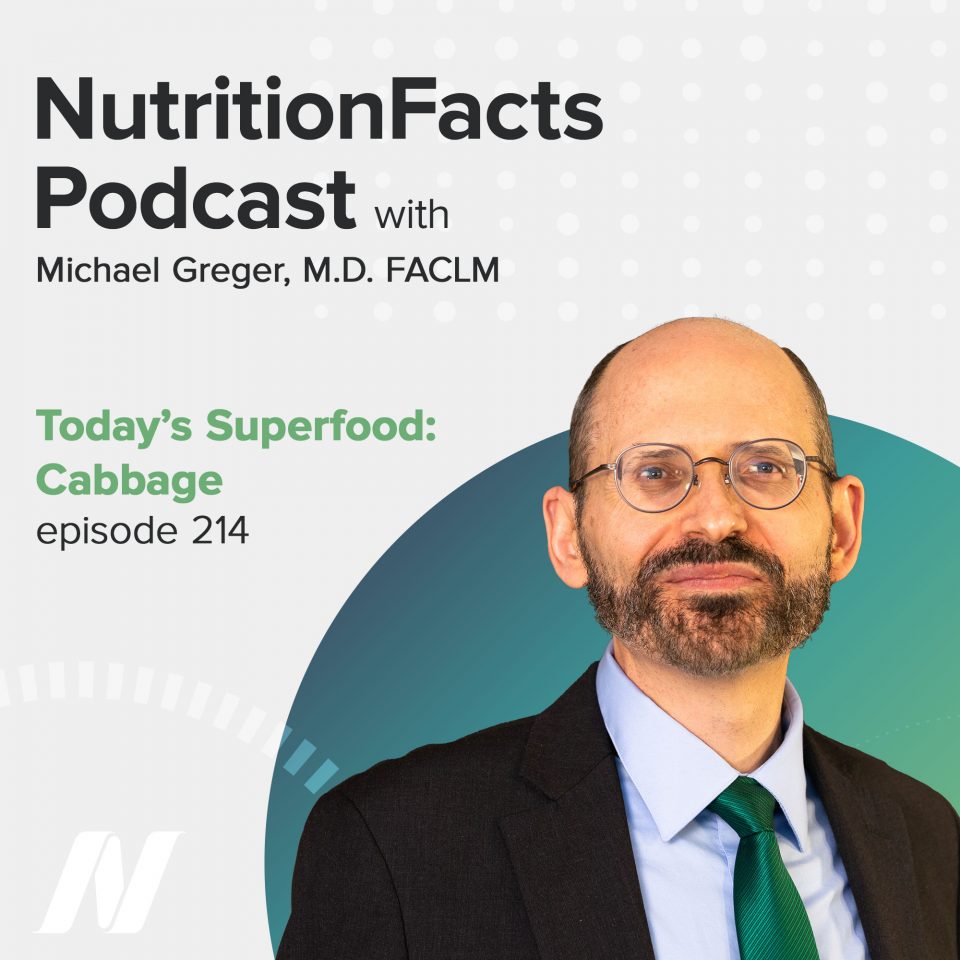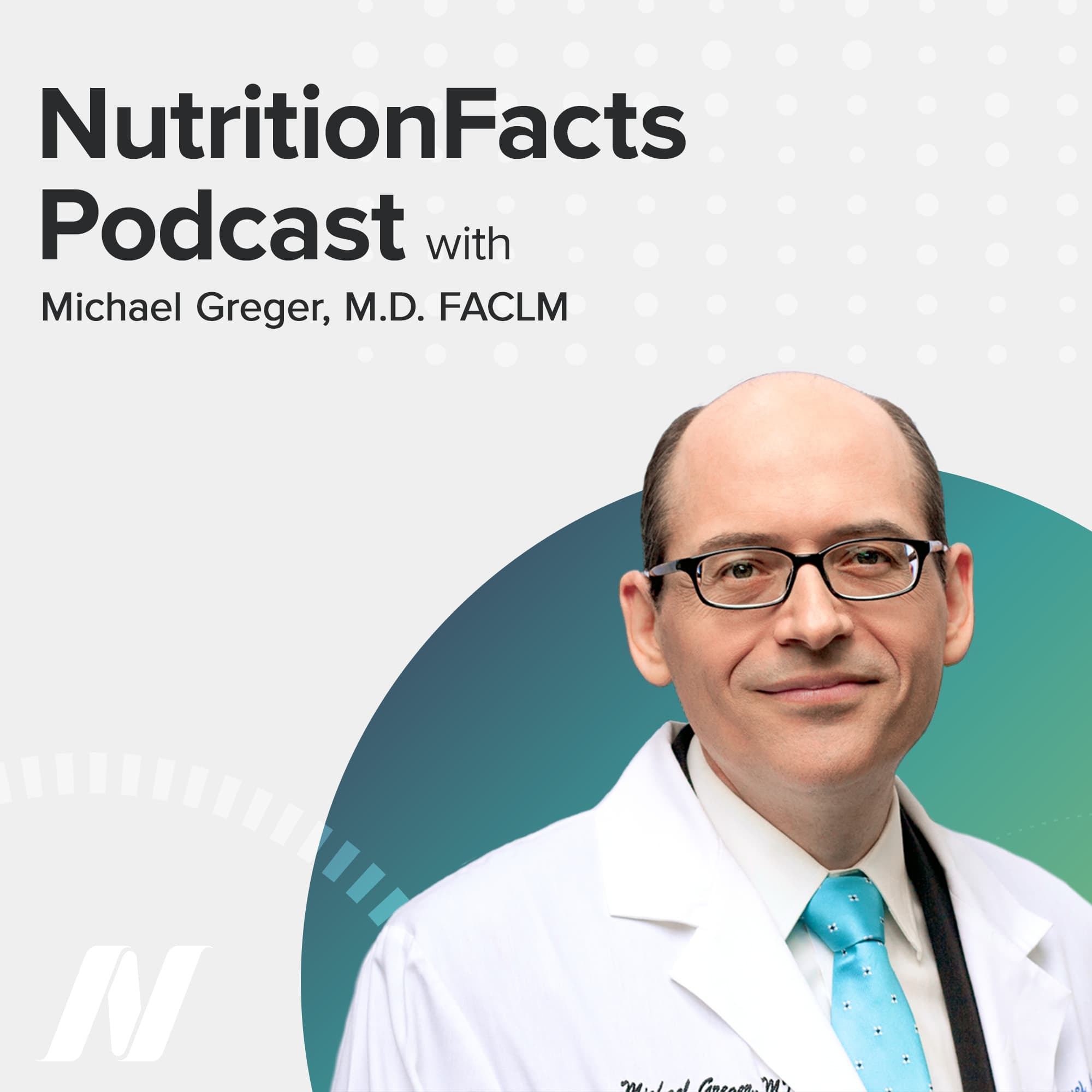Today, we experience the glory of cabbage, a multi-talented vegetable that’s good for much more than coleslaw. In fact, it is packed with nutrients and may also be useful applied topically, as one of the most healthy and cost-effective ways to improve your diet.
A few years ago, in an analysis of antioxidants per unit cost, I concluded that red cabbage—purple cabbage—was the most nutrition you could get for your money. Yes, there are healthier foods out there, but not healthier foods for the same amount of money. I encouraged everyone to always make sure they have a purple cabbage in their crisper, to slice off shreds to put in whatever they could. It lasts for weeks, is cheap, convenient, and one of the healthiest things on the planet. All still absolutely true. My new calculations, though, suggest they just got one-upped by DIY broccoli sprouts: do it yourself.
You can buy them online, or at your local health food store in bulk, for about 20 bucks a pound. But, that makes about 75 cups of sprouts; so, it comes out to be about 25 cents per cup. And, as we saw before, in terms of sulforaphane content, that’s equivalent to eating about 27 cups of broccoli. So, that’s like going to the store and buying broccoli for a penny a cup.
Start out with a mason jar with some kind of screen top. Tablespoon of seeds, soak them overnight, drain in the morning, and then rinse twice daily. So, day two, day three, day four, and then, you can enjoy the bounty. One tablespoon of seeds makes about two cups of sprouts. Since it takes four or five days, though, sometimes I’ll have five jars in constant rotation. Can be in the middle of winter, and I’m growing my own salad. Every day, you get cups of fresh produce, for pennies, without ever having to go to the store.
In our next story, dinosaur kale and red cabbage are put to the test.
LDL “bad” cholesterol is bad, but oxidized LDL may be worse. What role might our diet play? “Increased fruit and vegetable consumption has been reported to reduce the risk of developing [cardiovascular disease, heart attacks, and strokes].” Well, maybe it’s in part because of all the antioxidants in healthy plant foods preventing the oxidation of LDL cholesterol. And, indeed: “LDL oxidation resistance was [found to be] greatest” among those eating more plant-based. So, that would be “in addition to the decreased blood pressure” and lower LDL overall in terms of “beneficial effect[s].” But, you don’t know if it’s cause and effect, until you put it to the test. Put people on a whole food plant-based diet for just three weeks, and rates and extent of LDL oxidation drop.
“The effects of kale” on LDL oxidation were put to the test. Kale is a best-of-all-worlds food, low in calories and packed to the hilt with nutrition—vitamins, minerals, anti-inflammatory compounds, antioxidant phytonutrients—you name it. No surprise, then, given its “high antioxidant capacity… kale showed a protective effect on the oxidation of [LDL] even at low concentrations.” But, this was in vitro, in a test tube. Kale was also put to the test in mice. But, what about people?
I did a video on this study, on how “kale juice improves coronary artery disease risk factors in men with high cholesterol].” Extraordinary results: a 20% drop in LDL among the non-smokers. But, they were drinking the equivalent of about 10 cups of kale a day. Still, the fact that they were able to see an improvement, even though nearly all the fiber was removed, because it was just juice, shows there does seem to be something special in the plant. But, can you get the benefit just eating the stuff? Let’s find out.
“The effect of black and red cabbage on…oxidized [LDL].” And by black cabbage, they mean lacinato kale, also known as dinosaur or Tuscan kale. They had people eat a bag of frozen kale and cabbage a day for just two weeks—which is great because you can just keep it in the freezer, pre-washed, pre-chopped, and just throw it in any meal you are making—and got “significant reductions” of total cholesterol, LDL cholesterol, and even blood sugar levels. And, the antioxidant capacity of their blood went up. So, no surprise, they demonstrated “a significant decrease” in oxidized LDL, too.
Would it have been better to take that red cabbage and ferment it into sauerkraut? Red or purple cabbage is one of my favorite vegetables—packed with antioxidants, yet dirt cheap, and seems to last forever in the fridge. It’s pretty, and juicy, and tasty. I try to slice shreds off into any meal I’m making. But, when you ferment it, not only do you add way too much salt, but you end up wiping out some of the nutrition. Here’s the big spike in antioxidant capacity of your bloodstream in the hours after eating fresh red cabbage—cut down by almost 30% if you ate the same amount in fermented form. Does cabbage have to be raw, though?
No. Some “[c]ooking techniques may improve the…antioxidant activity in kale and red cabbage.” “The effects of the cooking process can be positive, since cooking softens the vegetable tissues,” helping your body extract the active compounds. “However, cooking can also be negative, because heat treatment can degrade [some of the] compounds. They looked at a variety of different cooking methods, and concluded “steaming [may] be considered to be the best home cooking technique to prepare kale and red cabbage.” But, with foods that healthy, the truly best way to prepare them is whatever way will get you to eat the most of them.
Next up, we discover some of the topical benefits of cabbage leaves.
In response to a photo showing a woman taping a cabbage leaf onto her knee to help with her osteoarthritis, doctors wrote in asserting that “Cabbage leaves can help inflammation of any body part….You may even find that there is a cache of cabbage in the fridge of your local maternity unit.” Why? Well, not only is cabbage cheaper than gel packs, but knees are not the only “anatomical shapes” that the leaves “conform well to.”
“Breast engorgement”—when the breasts become overfilled with milk during breastfeeding, becoming hard, tight, and painful—can negatively impact both mother and infant alike. So, why not put cabbage leaves on them? A lactation consultant in a breastfeeding journal suggests wearing cabbage leaves. Evidently works like a charm, and once the swelling goes down, “frequent breastfeeding” should help the breasts from refilling too much.
Where did she even get the idea for this? Well, her son got in a car accident, she “wrapped his leg in cabbage,” and the rest is history. The only adverse side effect identified was a complaint from the son, who felt “like a vegetable.”
“Based on the information [she] collected, [she concluded that] cool green cabbage compresses have anti-inflammatory, anti-edema [anti-swelling], and anti-infectious properties.” But, you don’t really know, until you…put it to the test. Yeah, but who’s going to do a randomized, controlled study of cabbage leaves? Scientists, that’s who. “Do cabbage leaves prevent breast engorgement?” Let’s find out.
120 women randomized to apply “cabbage leaves to their breasts,” or not. And, though the cabbage group “tended to report less breast engorgement,…the trend was not statistically significant,” though one of the big things you care about is premature weaning. And, the cabbage group did seem able to extend the time they were exclusively breastfeeding. So, while they couldn’t “rule out the possibility that cabbage leaves had a direct effect on breast engorgement,…that may have contributed to the increased breastfeeding success in the experimental group,” they “consider…the positive effect [to be] more likely [due to] psychological mechanisms”—in other words, the placebo effect. They did weed out some of the true believers, though, as some women refused to join the study out of fear they might end up in the control group, and not be able to use them.
A similar study performed recently found that while adding cabbage leaves to early breast care didn’t significantly reduce pain, it did seem to significantly reduce breast hardness. Since it probably can’t hurt, some women might want to just give it a try. But, it would be nice to get some more concrete answers. Like, how about a treatment trial instead of just prevention? You could try hot cabbage leaves versus cold cabbage leaves. To control for the placebo effect, you could use placebo cabbage, like iceberg lettuce leaves or something. In fact, since both breasts are affected, women could act as their own controls, with cabbage on one breast and turning over a new leaf on the other.
How about a comparison of “Chilled Cabbage Leaves [versus] Chilled Gel Packs”? Just cold alone “decreases blood flow” and might, therefore, “decrease engorgement.” On the other hand, maybe cabbage leaves contain some component “that the mother’s skin absorbs” that somehow helps. You don’t know, until you…put it to the test.
“Thirty-four lactating women with breast engorgement.” One breast got the cabbage; one breast got the gel pack. “Their pain levels were established [before and after]….” And: “There was no difference. They both appeared to work about just as well, with two-thirds reporting relief within hours either way—though, interestingly, “[t]he majority of mothers preferred the cabbage leaves.”
“The similarity in the effect…may have been caused by the fact that both applied cold,” although you’d think “the effects of the cold in the cabbage leaves would have been transitory.” So, hey, maybe there’s something special in cabbage leaves, after all? What you’d have to do is like a comparison of “Chilled [versus] Room Temperature Cabbage.” Okay, here you go! One breast gets the “chilled cabbage” leaf, and the other gets a “room-temperature cabbage” leaf. And, “There was no difference” between the two. They both seemed to work, suggesting that it’s not the cold itself that’s doing it. But, we still don’t know what role the placebo effect is playing.
If you were going to design a study to determine if there was some special compound in cabbage that could decrease breast engorgement, what would you do? You could try the iceberg lettuce. But, if women have heard about the cabbage effect, they might have an expectation bias in favor of the cabbage. Aha! How about using a “cabbage leaf extract”? Then, you can finally do a “double-blind experiment” where women don’t know which breasts are exposed to the cabbage by asking them to rub on a cream containing a cabbage-leaf extract versus a “placebo cream.” They added some rosewater to both creams to try to “camouflage any residual [cabbage] odor,” and “no difference” in relief. Now, “the decrease in discomfort produced by the cream…was not as strong as that produced by the real cabbage leaves…in [the] previous studies.”
The superiority of the whole leaves “might be explained by a failure of the extract to contain the potentially active chemical,” or maybe the chemical broke down, or maybe it wasn’t concentrated enough, or maybe there was just a powerful placebo effect of wearing cabbage leaves. The bottom line is that, “[e]ven though no active pharmacological substance in cabbage leaves has been identified…,its convenient shape [of cabbage leaves, their] low cost, wide availability, and purported soothing effect make it a sought after treatment.”

 Previous Podcast
Previous Podcast Next Podcast
Next Podcast